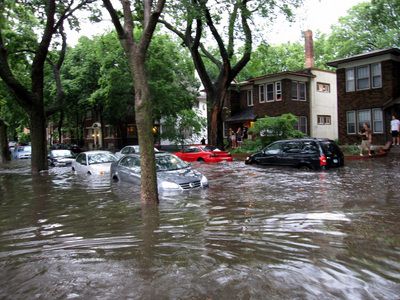For most of the people whose cars got caught by last evening’s flash floods — based purely on the images I’ve seen on NewsQ — big problems are unlikely. The fuel system is closed and electrical terminals are mostly higher on the firewall and frame than the water appears to have reached, and the water didn’t reach higher than the bottom of the wheel wells. The water will drain from the lower part of the engine and the electronics should be fine.
The people who are going to have the big problems are the people who tried to drive through the water. Here’s mechanic Ronnie Pucino:
If the engine is running when it is flooded, or if it is started with water in the system, the result is hydrolock, Pucino said. The piston cannot compress the water, thus cannot complete its cycle and seizes up when the connecting rods bend or break.
Not only will the engine have to be repaired, but it will have to be taken apart and cleaned of any water. If the rest of the vehicle is salvageable, it might be cheaper and quicker to get a new engine.
If water gets into the electronics, residual damage can cause problems for the life of the car.
“It will always have underlying issues,” Pucino said. That is why insurance companies write off cars with flooded dashboards.
If the water reached the dashboard, your car is probably toast. Most of the images I’ve seen show water to the floorboards, then your focus is on the upholstery and preventing mold. This will involve removing seats. The doors often have a plug to help remove moisture. Your door speakers may be history.
Flood water is usually contaminated with all sorts of bacteria. Mold will grow quickly, especially on the soundproofing that’s under much of the upholstery.
Here are some guidelines from Progressive.com:
Check your oil indicator.
A reading of an oil level that’s too high may tell you there’s water in the engine. Do not start or run your car — it could cause severe damage.
Measure the depth of the water that submerged your car.
It is possible water did not enter any parts that are susceptible to damage.
Determine how long your car was submerged.
The shorter the time, the more salvageable any damaged parts may be.
Be sure to note the type of water that flooded your vehicle.
Fresh water causes less damage to your car than salt water.
Check local weather reports for the temperature during and after flooding.
Warmer temperatures may speed up corrosion, especially if your car was flooded with salt water.
Determine how long your car was submerged.
The shorter the time, the more salvageable any damaged parts may be.
Here are some more tips via KTRK:
Much of the damage the water caused will be hidden. Your first call today should be to your insurance company. You also don’t want to drive your car — if it starts — to a car repair shop. Have it towed.
Don’t drive like my brother.
(Photo: Elizabeth Wefel, St. Paul)

